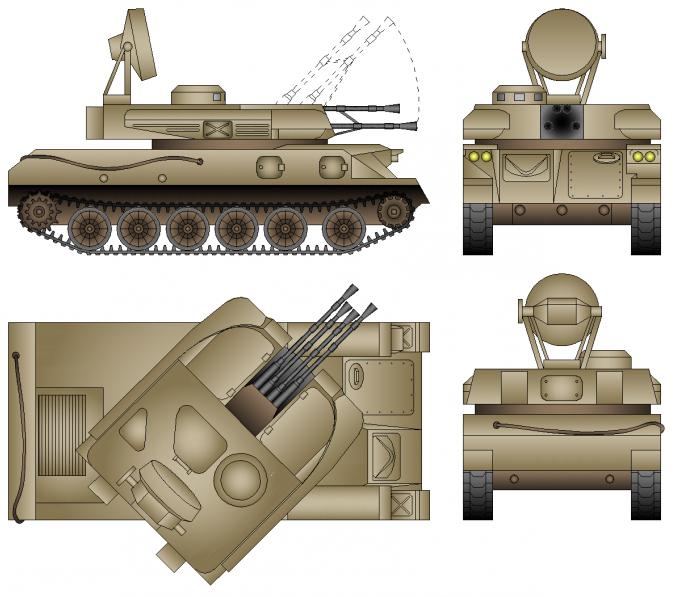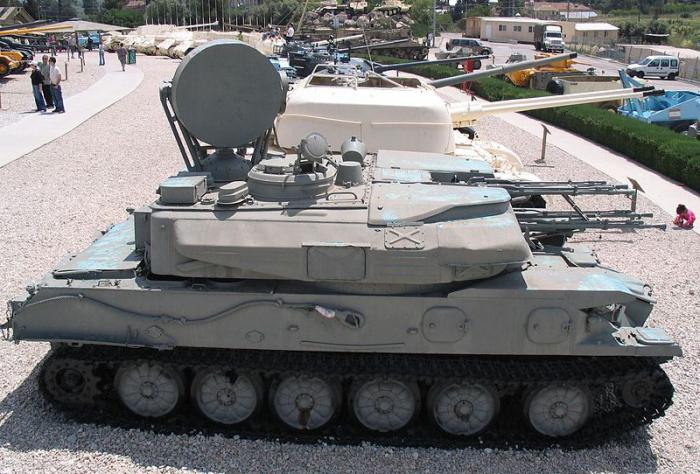In the first two decades after its appearance, aviation became a formidable fighting force. Naturally, funds immediately began to appear to counter its destructive onslaught. Even the simplest airplanes of the times of World War I could inflict significant damage on the troops of the warring parties. Then there was Spain, Abyssinia and many other conflicts that took place with the use of airplanes, often bombing defenseless positions or peaceful villages, without meeting resistance. However, the massive opposition to aviation began in 1939, when the Second World War happened. Air defense artillery has become a separate type of weaponry. Most often, the main problem of ground forces was represented by enemy attack aircraft operating at low altitudes and delivering accurate bombing strikes. This situation has not fundamentally changed over the past seven decades.
The historical background of the Shilka concept
Already at the end of the twenties of the XX century, many arms manufacturers, anticipating the growing demand, began to develop rapid-firing artillery systems, designed primarily to combat air targets. As a result, samples of small-caliber guns appeared on turret racks equipped with circular rotary mechanisms. Examples include German FlaK anti-aircraft guns (short for Flugzeugabwehrkanone), adopted by the Wehrmacht in 1934. During the war that began five years later, they were repeatedly modernized and produced in huge numbers. The Erlikons developed in Switzerland (1927) and used by all the warring parties of the Second World War became very famous. The systems have shown high efficiency in the defeat of attack aircraft, forced to operate at low altitude. The caliber of these quick-firing guns was usually 20 mm with different cartridge lengths (the initial speed, and therefore the range, depends on the volume of explosives in the cartridge case). The increase in rate of fire was achieved by the use of multi-barrel systems. So the general concept was formed, according to which the Soviet Shilka self-propelled anti-aircraft gun was subsequently created.
Why do I need a self-propelled anti-aircraft gun
In the 50s, rocketry appeared, including anti-aircraft. Strategic bombers and reconnaissance aircraft, previously feeling quite confident in a strange sky, suddenly lost their inaccessibility. Of course, the development of aviation went along the path of increasing the ceiling and speed, but it became unsafe for ordinary attack aircraft to appear above enemy positions. True, they had one reliable way not to get hit by an air defense missile, and it consisted of approaching the target at extremely low altitude. At the end of the 60s, the USSR anti-aircraft artillery was not ready to reflect the attacks of enemy aircraft flying along the flat trajectory at high speed. The response time turned out to be extremely short, a person with even the fastest “boxing” reflexes could not physically manage to open fire, much less hit the target, flashing in the sky in seconds. Automation and reliable detection systems were required. In 1957, a secret decision of the Council of Ministers initiated the start of work on the creation of rapid-fire ZSU. They came up with the name: self-propelled anti-aircraft installation "Shilka". It was a small matter: to design and manufacture it.

What is ZSU?
Requirements for the new technology included many points, among which were many unique to our gunsmiths. Here are some of them:
- The Shilka anti-aircraft gun should have a built-in radar for detecting hostile aircraft.
- Caliber - 23 mm. It is, of course, small, but the practice of previous military operations showed that, with a high rate of fire, an explosive fragmentation charge could well cause damage sufficient to neutralize the combat effectiveness of the attacking apparatus.
- The system should include an automatic device that develops an algorithm for tracking the target during firing under different conditions, including on the move. Given the elemental base of the mid-20th century, the task is not an easy one.
- Installation "Shilka" must be self-propelled, capable of moving over rough terrain no worse than any tank.
Guns
The artillery of the USSR from Stalin's time was the best in the world, therefore, in everything that related to the "trunks", there were no questions. It only remained to choose the best option for the charging mechanism (the best was recognized as a ribbon). Automatic gun 23 mm caliber Amur AZP-23 with an impressive "performance" of 3400 rds / min. needed forced liquid cooling (antifreeze or water), but it was worth it. Any target within a radius of 200 m to 2.5 km had little chance of surviving when it fell into the crossroads of the sight. The trunks were equipped with a stabilization system, their position was controlled by hydraulic drives. There were four guns.
Where to put the radar antenna?
ZSU-23 "Shilka" is structurally made according to the classical scheme with a fighting compartment, aft power plant, rear transmission and a movable tower. Some problems arose with the placement of the radar antenna. It was not rational to place it between the trunks; metal parts could become a screen for the emitted and received signals. The lateral position threatened the mechanical destruction of the "plate" from vibrations that occur during firing. In addition, under conditions of strong electronic countermeasures (exposure to interference), a manual control option was provided with aiming through the gunner’s sight, and the design of the emitter could block the view. As a result, the antenna was made folding and placed it above the power compartment at the stern.
Motor and chassis
Chassis borrowed from the light tank PT-76. It includes six road wheels on each side. Torsion shock absorbers, tracks are equipped with rubber bushings-seals to protect against premature wear.
Forced engine (6), power 280 l. with., with an ejection cooling system. The five-speed transmission provides a range from 30 km / h (on difficult terrain) to 50 km / h (on the highway). Cruising range without refueling - up to 450 km / h with fully filled tanks.
The ZU-23 installation is equipped with a perfect air filtration system, including a labyrinth system of partitions, as well as an additional screening of pollution by exhaust gas.
The total mass of the car is 21 tons, including towers - more than 8 tons.
Devices
Electronic equipment, which is equipped with self-propelled anti-aircraft installation "Shilka", is combined into a single RPK-2M firing control system. The composition of the radio complex includes a radar (1RL33M2, assembled on a lamp element base), an on-board computer (at the time of the creation of the sample it was called a counting and resolving device), a radio noise protection system that duplicates an optical sight.
The complex provides the ability to detect a target (at a distance of up to 20 km), automatically track it (up to 15 km), change the carrier frequency of pulses in the event of jamming (wobble), calculate fire parameters to achieve a high probability of projectile impact. The system can operate in five modes, including memorizing the coordinates of an object, determining its angle rings and firing at ground targets.
External communication is carried out via the R-123M radio station, internal communication via TPU-4 intercom.
Respectable age and application experience
Self-propelled anti-aircraft installation "Shilka" was adopted more than half a century ago. Despite the age so venerable for anti-aircraft weapons, four dozen states still have it in the arsenal of their armed forces. The Israeli army, which in 1973 experienced the crushing action of the four barrels of this SZU on its aircraft, continues to use sixty copies seized from Egypt, plus additional ones bought later. In addition to the republics that previously made up the USSR, Soviet anti-aircraft guns are ready in case of war to use many states of Africa, Asia and the Arab world. Some of them have experience in the combat use of these air defense systems, which managed to fight both in the Middle East and Vietnam (and by no means with weak opponents). They are also in the armies of the former Warsaw Pact countries, and in considerable numbers. And what is characteristic: ZU-23 is nowhere and no one calls antiques or another nickname that characterizes obsolete weapons.

Upgrades and Prospects
Yes, the good old Shilka is no longer young. The anti-aircraft installation has gone through several upgrades aimed at improving performance and increasing reliability. She learned to distinguish her planes from strangers, began to act faster, electronics received new blocks on a modern elemental base. The last “upgrade” took place in the nineties, at that time, apparently, the modernization potential of this system was exhausted. In place of "Shilkam" come the "Tunguska" and other SZU, which have much more serious capabilities. A modern combat helicopter can hit the ZU-23 from a distance inaccessible to it. What can you do, progress ...